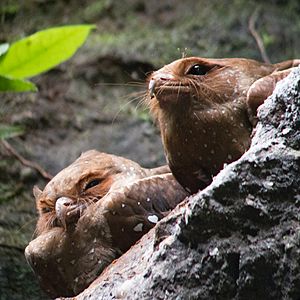Steatornithidae facts for kids
Quick facts for kids Steatornithidae |
|
|---|---|
 |
|
| Oilbirds (Steatornis caripensis) resting in their cave | |
| Scientific classification |
|
| Kingdom: | Animalia |
| Phylum: | Chordata |
| Class: | Aves |
| Clade: | Strisores |
| Order: | Caprimulgiformes Mayr, 2010 |
| Family: | Steatornithidae Bonaparte, 1842 |
| Genera | |
|
|
Steatornithidae is a special family of birds. It includes only one living species, the famous Oilbird (Steatornis caripensis). This family also once included a group of birds that are now extinct, called Euronyctibius.
Contents
What are Steatornithidae?
The Steatornithidae family is unique because it contains only the Oilbird today. These birds are known for their amazing ability to fly in the dark using sound, much like bats do. They are also the only night-flying birds that eat fruit.
The Oilbird: A Nighttime Fruit Eater
The Oilbird is a fascinating creature. It lives in caves and comes out at night to find food. Unlike most night birds that hunt insects or small animals, Oilbirds eat mostly fruit. They especially love the fruit of oil palms and tropical laurels. This diet gives them a lot of energy and makes them quite oily, which is how they got their name!
Where Do Oilbirds Live?
Oilbirds are found in northern South America and on the island of Trinidad. They prefer to live in deep caves, which provide a safe place to rest during the day and raise their young. These caves can be very large, sometimes home to thousands of Oilbirds.
Oilbirds have excellent night vision, but they also use a special skill called echolocation. This means they make high-pitched clicking sounds. When these sounds bounce off objects, the birds hear the echoes. This helps them create a sound map of their surroundings, allowing them to fly safely through dark caves and dense forests at night. It's similar to how bats find their way around!
How Scientists Classify Steatornithidae
For a long time, scientists grouped the Steatornithidae family with other night-flying birds like nightjars. This larger group was called Caprimulgiformes. However, newer scientific studies have shown that Steatornithidae is quite different from these other birds.
A Family of Their Own
Today, most scientists agree that Steatornithidae belongs in its own special group, or order, called Steatornithiformes. This means they are considered unique enough to have their own distinct branch on the bird family tree. This change in classification happened because of new research into bird genetics and how different bird groups are related.

